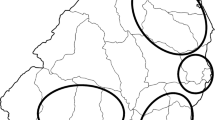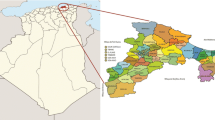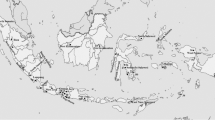Abstract
Olive leaf spot caused by the fungus, Spilocaea oleagina, is the most important leaf disease of olives in many olive-growing regions worldwide with yield losses of up to 20%. The genetic structure of S. oleagina populations was investigated with universally primed-polymerase chain reaction (UP-PCR) techniques. Ninety-eight S. oleagina isolates were collected from 12 known and 4 unknown cultivars from olive groves in five New Zealand regions. UP-PCR profiles based on 159 markers were used to compute genetic distances between pairs of individuals. Low levels of gene and genotypic diversity were detected in all populations, with 76% of the loci being polymorphic and with Nei’s diversity indices ranging from 0.0234 to 0.1393. Analysis of molecular variance showed small but significant (P = 0.001) variations among regions, although most of the molecular variability (87%) was found within populations. Clustered analysis showed no evidence of grouping according to geographic origin of the isolates. The low level of genetic diversity found within and among populations indicates that reproduction for this fungus is predominantly by asexual means and that any effective control strategies are likely to be useful in all or most New Zealand olive groves.
Similar content being viewed by others
References
Bernès J (1923) Les parasites de l’olivier au congrès oleicole de Nice. Progress in Agriculture and Viticulture 80, 518–524.
Bulat SA, Lübeck M, Mironenko N, Jensen DF, Lübeck PS (1998) UP-PCR analysis and ITS1 ribotyping of strains of Trichoderma and Gliocladium. Mycological Research 102, 933–943. doi:10.1017/S0953756297005686
Burdon JJ, Roelfs AP (1985) The effect of sexual and asexual reproduction on the isozyme structure of populations of Puccinia graminis. Phytopathology 75, 1068–1073. doi:10.1094/Phyto-75-1068
Crawford MS, Chumley FG, Weaver CG, Valent B (1986) Characterization of the heterokaryotic and vegetative diploid phases of Magnaporthe grisea. Genetics 114, 1111–1129.
Cumagun CJR, Hockenhull J, Lübeck M (2000) Characterization of Trichoderma isolates from Philippine rice fields by UP-PCR and rDNA-ITS1 analysis: identification of UP-PCR markers. Journal of Phytopathology 148, 109–115. doi:10.1046/j.1439-0434.2000.00467.x
De Marzo L, Frisullo S, Rossi V (1993) Possible dissemination of Spilocaea oleagina conidia by insects (Ectopsocus briggsi). EPPO Bulletin 23, 389–391. doi: 10.1111/j.1365-2338.1993.tb01341.x
Excoffier L, Smouse PE, Quattro JM (1992) Analysis of molecular variance inferred from metric distances among DNA haplotypes: application to human mitochondrial DNA restriction sites. Genetics 131, 479–491.
Excoffier L, Laval G, Schneider S (1997) Arlequin version 3.01: an integrated software package for population genetics data analysis. Evolutionary Bioinformatics Online 1, 47–50.
Gonzàlez-Lamothe R, Segura R, Trapero A, Baldoni L, Botella MA, Valpuesta V (2002) Phylogeny of the fungus Spilocaea oleagina, the causal agent of peacock leaf spot in olive. FEMS Microbiology Letters 210, 149–155.
Goodwin SB, Saghai-Maroof MA, Allard RW, Webster RK (1993) Isozyme variation within and among populations of Rhynchosporium secalis in Europe, Australia and the United States. Mycological Research 97, 49–58. doi:10.1016/S0953-7562(09)81112-X
Gouveia MMC, Ribeiro A, Varzea VMP, Rodrigues-Junior CJ (2005) Genetic diversity in Hemileia vastatrix based on RAPD markers. Mycologia 97, 396–404. doi:10.3852/mycologia.97.2.396
Graniti A (1993) Olive scab: a review. EPPO Bulletin 23, 377–384. doi:10.1111/j.1365-2338.1993.tb01339.x
Guechi A, Girre L (1994) Sources of Cycloconium oleaginum (Cast.) conidia for infection of olive leaves and conditions determining leaf spot disease development in the region of Sètif, Algeria. Mycopathologia 125, 163–171. doi:10.1007/BF01146522
Hovmøller MS, Østergård H (1991) Gametic disequilibria between virulence genes in barley powdery mildew populations in relation to selection and recombination. II. Danish observations. Plant Pathology 40, 178–189. doi:10.1111/j.1365-3059.1991.tb02365.x
Kohn LM (1995) The clonal dynamic in wild and agricultural plant-pathogen populations. Canadian Journal of Botany 73, 1231–1240. doi:10.1139/b95-383
Laviola C (1968) Aspetti biologici ed epifitologici disease Spilocaea oleagina (Cast.) Hugh. in Italia. Annali Facoltura Agraria University, Bari 22, 345–360.
Lops F, Frisullo S, Rossi V (1993) Studies on the spread of the olive scab pathogen Spilocaea oleagina. EPPO Bulletin 23, 385–387. doi:10.1111/j.1365-2338.1993.tb01340.x
Lübeck PS, Alekhina IA, Lübeck M, Bulat SA (1998) UP-PCR genotyping and rDNA analysis of Ascochyta pisi Lib. Journal of Phytopathology 146, 51–55.
Lübeck M, Alekhina IA, Lübeck PS, Jensen DF, Bulat SA (1999) Delineation of Trichoderma harzianum into two genotypic groups by a highly robust fingerprinting method, UP-PCR, and UP-PCR product cross-hybridization. Mycological Research 103, 289–298. doi:10.1017/S0953756298007126
MacDonald AJ, Walter M, Trought M, Frampton CM, Burnip G (2000) Survey of olive leaf spot in New Zealand. New Zealand Plant Protection 53, 126–132.
MacHardy WE (1996) ‘Apple scab: biology, epidemiology, and management.’ (The American Phytopathological Society Press: St Paul, MN)
McDermott JM, McDonald BA (1993) Gene flow in plant pathosystems. Annual Review of Phytopathology 31, 353–373. doi:10.1146/annurev. py.31.090193.002033
McDonald BA (1997) The population genetics of fungi: tools and techniques. Phytopathology 87, 448–453. doi:10.1094/PHYTO.1997.87.4.448
McDonald BA, Pettway RE, Chen RS, Boeger JM, Martinez JP (1995) The population genetics of Septoria tritici (teleomorph Mycosphaerella graminicola). Canadian Journal of Botany 73, 292–301. doi:10.1139/b95-259
Miller HN (1949) Development of the leaf spot fungus in the olive leaf. Phytopathology 39, 403–410.
Nei M (1973) Analysis of gene diversity in subdivided populations. Proceedings of the National Academy of Sciences of the United States of America 70, 3321–3323. doi:10.1073/pnas.70.12.3321
Newman PL, Owen H (1985) Evidence of asexual recombination in Rhynchosporium secalis. Plant Pathology 34, 338–340. doi:10.1111/j.1365-3059.1985.tb01370.x
Obanor FO, Walter M, Jones EE, Jaspers MV (2008) Effect of temperature, relative humidity, leaf wetness and leaf age on Spilocaea oleagina conidium germination on olive leaves. European Journal of Plant Pathology 120, 211–222. doi:10.1007/s10658-007-9209-6
Pottinger B, Stewart A, Carpenter M, Ridgway HJ (2002) Low genetic variation detected in New Zealand populations of Phaeomoniella chlamydospora. Phytopathologia Mediterranea 41, 199–211.
Raymond M, Rousset F (1995) An exact test for population differentiation. Evolution 49, 1280–1283. doi:10.2307/2410454
Shabi E, Birger R, Lavee S, Klein I (1994) Leaf spot (Spilocaea oleaginea) on olive in Israel and its control. Acta Horticulturae 356, 390–394.
Slatkin M (1987) Gene flow and geographic structure of natural populations. Science 236, 787–792. doi:10.1126/science.3576198
Tegli S, Santilli E, Bertelli E, Surico G (2000) Genetic variation within Phaeoacremonium aleophilum and Phaeoacremonium chlamydosporum in Italy. Phytopathologia Mediterranea 39, 156–161.
Tenerini I (1964) Researches on the biology and epidemiology of Spilocaea oleagina, the causal agent of the olive scab disease. Phytopathologia Mediterranea 3, 63–70.
Tenzer I, Gessler C (1997) Subdivision and genetic structure of four populations of Venturia inaequalis in Switzerland. European Journal of Plant Pathology 103, 565–571. doi:10.1023/A:1008636913211
Teviotdale BL, Sibbett GS (1995) Consistent annual treatment helps future olive leaf spot control. California Agriculture 49, 27–32. doi: 10.3733/ca. v049n05p27
Williams JGK, Kubelik AR, Livak KJ, Rafalski JA, Tingey SV (1990) DNA polymorphism amplified by arbitrary primers are useful as genetic markers. Nucleic Acids Research 18, 6531–6535. doi:10.1093/nar/18.22.6531
Wilson EE, Miller HN (1949) Olive leaf spot and its control with fungicides. Hilgardia 19, 1–24.
Wilson EE, Ogawa JM (1979) ‘Fungal, bacterial, and certain nonparasitic diseases of fruit and nut crops in California.’ (Division of Agricultural Science, University of California: Berkeley) 190 pp.
Wright S (1951) The genetical structure of populations. Annals of Eugenics 15, 323–354.
Yeh C, Yang RC, Boyle T (1999) POPGENE version 1.32. Microsoft Windows-based Freeware for population genetic analysis. Available at http://www.ualberta.ca/~fyeh/index.htm [Verified 29 June 2010]
Zeigler RS, Cuoc LX, Scott RP, Bernardo MA, Chen DH, Valent B, Nelson RJ (1995) The relationship between lineage and virulence in Pyricularia grisea in the Philippines. Phytopathology 85, 443–451. doi:10.1094/Phyto-85-443
Zeigler RS, Scott RP, Leung H, Bordeos AA, Kumar J, Nelson RJ (1997) Evidence of parasexual exchange of DNA in the rice blast fungus challenges its exclusive clonality. Phytopathology 87, 284–294. doi:10.1094/PHYTO.1997.87.3.284
Zhang N, Blackwell M (2002) Population structure of dogwood anthracnose fungus. Phytopathology 92, 1276–1283. doi:10.1094/PHYTO.2002. 92.12.1276
Zuccon A, Zuccon D (2008) MrEnt version 2. Program distributed by the authors. Available at http://www.mrent.org [Verified 29 April 2010]
Author information
Authors and Affiliations
Corresponding author
Rights and permissions
About this article
Cite this article
Obanor, F.O., Walter, M., Jones, E.E. et al. Genetic variation in Spilocaea oleagina populations from New Zealand olive groves. Australasian Plant Pathology 39, 508–516 (2010). https://doi.org/10.1071/AP10013
Received:
Accepted:
Issue Date:
DOI: https://doi.org/10.1071/AP10013




